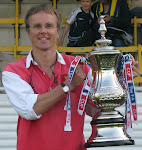FA Cup, fourth qualifying round
Attendance: 668
 Rather like at my previous tie at Guisborough the
hosts won the first half on points but had no goals to show for it and you
always felt the visitors would make their higher status tell. (Conference North
leaders Hednesford came into the match having lost only one League match all
season while Stamford had only won two and lie close to the foot of the
division below). Hednesford scored twice in the second half, both from soft
penalties (the first pictured, below). They were the stronger side overall and deserved to win but, for the
Daniels, this must have been a galling way to go out particularly at such an
advanced stage.
Rather like at my previous tie at Guisborough the
hosts won the first half on points but had no goals to show for it and you
always felt the visitors would make their higher status tell. (Conference North
leaders Hednesford came into the match having lost only one League match all
season while Stamford had only won two and lie close to the foot of the
division below). Hednesford scored twice in the second half, both from soft
penalties (the first pictured, below). They were the stronger side overall and deserved to win but, for the
Daniels, this must have been a galling way to go out particularly at such an
advanced stage.
 Programme notes: The Hednesford squad included
Cameroonian Charlie Anagho-Ntamark. His surname reads like a couple of sets of Scrabble
tiles. The Pitmen have two players with European experience: Nathan Woolfe with Bolton in the
UEFA Cup in 2007 and Wayne Riley with Airbus in the Europa League qualifiers last July. Neil Harvey is a Barbadian international. An ‘in the hot
seat’ feature reveals that Richard Jones of The Daniels has a phobia of worms
and doesn’t like swedes either. Outstanding publication, by the way.
Programme notes: The Hednesford squad included
Cameroonian Charlie Anagho-Ntamark. His surname reads like a couple of sets of Scrabble
tiles. The Pitmen have two players with European experience: Nathan Woolfe with Bolton in the
UEFA Cup in 2007 and Wayne Riley with Airbus in the Europa League qualifiers last July. Neil Harvey is a Barbadian international. An ‘in the hot
seat’ feature reveals that Richard Jones of The Daniels has a phobia of worms
and doesn’t like swedes either. Outstanding publication, by the way.

Attendance: 668
The journey to Stamford is something of a pilgrimage
for groundhoppers but not for much longer. One of the best loved non-league
grounds in the country in a stunning but little known Georgian stone town closes
at the end of the season when the club moves to a new out of town stadium. I’d tried
to avoid viewing pics of the existing ground online as I wanted to see it for
real first and today’s tie - with Stamford bidding to reach the first round
proper of the FA Cup for the first time ever - was the ideal opportunity.
Cameras are usually focused on three features: a
church tower, row of almshouses (just the other side of a fence), and century
old wooden main stand with red dogtooth fascia bearing the letters SAFC which
you imagine would tumble to the ground if struck by an errant pass. The ‘A’
stands for association. The club is not called ‘Stamford Town’ either; the
extra syllable just works better for chants not that there were many today. In
fact – and for my third round running – the away fans were more vocal than
their hosts.
Hailing from a Black Country former mining
community, Hednesford are nicknamed the Pitmen. One of their fans sported a
white miner’s hard hat with the initials HT painted in black on the sides and
‘The Pitmen’ on the front. Stamford have a great nickname too: the Daniels
which is derived from Daniel Lambert, England’s heaviest man (at the time), who
died in the town in 1809 weighing 52 stone.
The nickname is everywhere; the locals clearly cherish it.
For what was billed as Stamford’s biggest cup tie
for 40 years the atmosphere was a little low key. The mature crowd was modest
both in number and demeanor and typified by the mayor in this chains.
“The men who could make history” was how a montage
of Daniels’ pics was headed in the programme. Sadly not today. This season’s
history is likely to be limited to the final match at the grand old ground next
April with an appetiser against a potentially promotion chasing FC United of
Manchester on Easter Saturday. Put at least one of them in your diary.
North/south divide: Distinct lack of teams from the north in the fourth qualifying round draw: just 14 out of 66.





